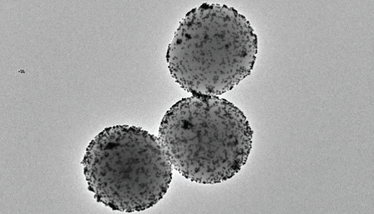Bladder Runner
Self-propelled nanoparticles can reduce tumors in the bladder by 90 percent
Rob Coker | | 2 min read | Technology

Image Credit: Institute for Bioengineering of Catalonia (IBEC)
“It’s a shame she won’t live. But then again, who does?” said Officer Gaff at the end of 1982’s Blade Runner. But for bladder cancer patients, sci-fi-esque technology may bring hope of life. Specifically, a team at the Institute for Bioengineering of Catalonia (IBEC) has developed urea-powered nanobots that deliver radionuclide therapy exactly where it’s needed.
The nanoparticles consist of a porous silica sphere, which carries various components with specific functions on its surface. Among these are urease, which enables the nanoparticle to propel itself; and radioactive iodine for localized treatment of tumors. In vivo studies in mouse models have shown a 90 percent reduction in tumor volume, which could lead to fewer hospital visits, shorter hospital stays, and a huge reduction in the burden placed upon healthcare institutions.
“Treating tumor-bearing mice with intravesically administered radio-iodinated nanobots for radionuclide therapy resulted in a tumor size reduction of about 90 percent, positioning nanobots as efficient delivery nanosystems for bladder cancer therapy,” write the study authors (1).
The nanorobots broke down the extracellular matrix of the tumor by increasing the pH through their self-propelling chemical reaction, favoring greater tumor penetration and achieving preferential accumulation.
According to the WHO International Agency for Research on Cancer, bladder cancer is the 10th most common cancer type, with 600,000 new diagnoses and 200,000 deaths each year (2). Bladder cancer tumors also have an alarmingly high recurrence rate – and though current treatments display good survival rates, therapeutic efficacy is relatively low.
The use of nanorobots delivering therapeutic agents directly to the tumor represent an ongoing means of study for the IBEC engineers, who hope that recurrence levels can be reduced as drastically as the tumor volumes themselves.
- S Sanchez et al, “Urease-powered nanobots for radionuclide bladder cancer therapy”, Nat. Nanotechnol. (2024) DOI: 10.1038/s41565-023-01577-y
- “Bladder Cancer”, IARC. Available at : https://bit.ly/4900oFC
Following a Bachelor’s degree in English Literature and a Master’s in Creative Writing, I entered the world of publishing as a proofreader, working my way up to editor. The career so far has taken me to some amazing places, and I’m excited to see where I can go with Texere and The Medicine Maker.



















